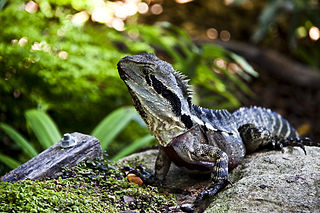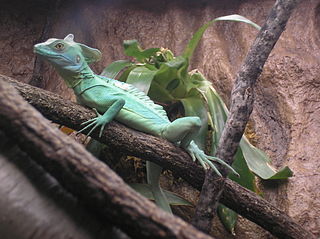Water Lizard, Dragon and Basilisk Proper Care and Information
Water lizard species are unique in that they need to be able to dip their entire body into the water and require high humidity levels (between 60% and 80% depending on the lizard). Some reptiles conduct a good part of their everyday life in the water including feeding. These lizards are from tropical rainforests, live in trees (arboreal) and require large enclosures.
Water Dragons
These South East Asia and Australian lizards are popular pets. Two species of the Southeast Green Water Water are bred for captivity. The average adult grows to 2 to 3 feet in 1 to 2 years and can live up to 15 years. Water Dragons can be hard to handle and are easily frightened. They can get used to a caretaker. Males are larger than females. Breeding can occur at age 2 to 3 years.
- Water Dragon Diet: Insects including crickets, king mealworms, silkworms, waxworms, earthworms, frozen pinkie mice, small fish, some flowers, fruit, and canned cat food (cat food might add more fat than is needed into the diet). Also feed dark leafy greens including mustard, kale, dandelion and collard greens. Other acceptable foods are peas, green beans, corn, squash, carrots, sweet potato, cucumber, zucchini, green peppers and parsley. All vegetables and greens should be chopped. Feed a variety of food.
- Insects should be "gut loaded" with calcium. If you breed your own crickets use a product such as Fluker's cricket food. Calcium supplements should not have vitamin D and have a ratio of calcium:phosphorous of 2:1. Provide calcium dusted food 1x per week.
- Feeding Schedule: Adults are fed every 2 to 3 days, younger Water Dragons are fed daily. A calcium supplement and a multi-vitamin should be sprinkled on food.
- Lizard Cage: Given size, should be kept in a large cage such as a 75 gallon aquarium (6 ft x 3 ft x 7 ft). Humidity levels should be between 60% to 80% via misting the cage every day. Cage tops should be screen mesh and sturdy. Must have a large bathing area.
- Substrate: Cover the cage bottom with a mulch such as coconut fiber or repti-bark. Change if the lizard eats the substrate to a repti-carpet. Change mulch substrates often to avoid the formation of bacteria and fungus.
- Cage Furniture: Use branches and stacking rocks that can be climbed. Look for river rocks and limestone slabs. Create a hiding place.
- Temperature: Heat basking area to 80F to 86F with a basking area that is 95F (35C). Night temperatures should be 10 to 15 degrees cooler. Use a ceramic heat source such as a Repticare ceramic heat lamp or an under tank heater. Do not use "hot rocks".
- Plants: Only buy lizard safe plants such as Pothos, Cracenae, Hibiscus, Philodendrons, Spider Plants and Staghorn Ferns.
- Lighting: UVB light should be on 10 to 12 hours a day. Use an incandescent day bulb.
- Sanitation: Clean the tank by removing the lizard first. Then clean with a 3% bleach solution.
- Health Concerns: If the Water Dragon is suffering from weight loss, decrease in appetite, swelling, lethargy, skin sores, paralysis, breathing problems or feces that doesn't look normal, see a veterinarian.
- Water Lizard Handling: Do not handle tail since it can break off. Hold the water lizard with two hands. Avoid sharp nails, which should be trimmed.
 Water Dragon in Roma St. Parklands, Australia
Water Dragon in Roma St. Parklands, Australia
Source: Loughi, Wikimedia
Basilisk Water Lizard
There are four species of Basilisk Water Lizards. They are native to Mexico, Central and South America. The Basilisk can grow to as long as 28 inches (71 cm). They are nervous in nature and will quickly move around a terrarium. This water lizard specie will require a opaque terrarium cover to reduce the amount of stress on the lizard. Colors may fade over time when kept in captivity. They must have a heat lamp heated basking area in addition to water filled areas.
Types of Basilisk Water Lizard species found in captivity include:
- Green Basilisk
- Red-Headed Basilisk
 Green Basilisk Lizard
Green Basilisk Lizard
Source: Museum of Natural History
- Lizard Cages: The Basilisk should be kept outdoors if possible in an enclosure that is 4 ft x 4 ft x 6 ft tall. Smaller Basilisks can be kept in smaller cages that are 3 ft x 3 ft x 5 feet tall.
- Furniture: Cages should have branches for climbing and a large water bowl.
- Substrates: Outdoor enclosures can have soil. Indoor cages can use mulch or sphagnum.
- Lighting: Use UVB lizard lights. Basking areas are heated with a ceramic heater to 95F.
- Basilisk Lizard Diet: Feed a variety of foods such as:
- Crayfish, crickets, locusts, grasshoppers, flies, beetles, ants, shrimp, super worms, deaths head roaches
- Vegetables such as seeds.
- Fruit: berries, leaves
- Basilisk Health: Concerns include parasites (nematodes, flagellates, coccidia), blurred eyes, eye infections (if cage is too dry).
Have a Pet Question for our Vet? We'll Answer it for Free!
Would you like to ask our Veterinarian a question? Just ask and we'll get back at you with an answer from our Vet for free!
If you need an immediate response, we suggest trying this online veterinary service that is available now to answer your questions.

